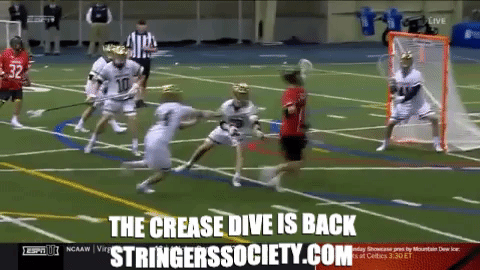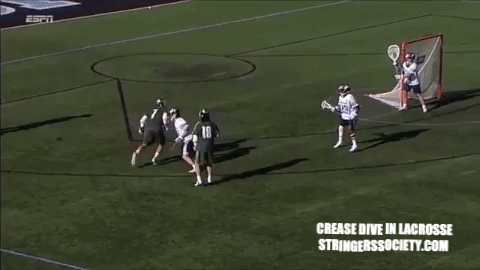Here we’ll address some easy pros and cons to the return of the dive to the lacrosse rules that most fans should be able to appreciate. Just like any other move-in lacrosse, the crease dive should become a viable option for any player looking to score. The main reason that it is potentially returning may also be to increase scoring. For now, all we can do is discuss and wait.

The Crease Dive Returns to NCAA Men’s Lacrosse in 2019
Let’s be real for a second. Offense sells tickets, and lacrosse needs ticket sales. Or higher viewership. Whichever way you watch NCAA men’s lacrosse, you will probably want to watch more of it now that the dive is back. With many recent rule changes to lacrosse stringing and head rules benefiting defenses, it is nice to see a rule change that helps out the offense. Another way to score should theoretically increase scoring; however, this is only currently a rule suggestion that will be approved or denied very shortly.
In order to really focus on this rule change, let’s examine the change and then the pros and cons.
How will the crease dive work in NCAA men’s lacrosse?
- Players may now voluntarily leave their feet and enter the crease to score a goal
- The ball must enter the goal before the player touches the crease to count
- Players must be moving in a direction away from the mouth of the goal
- Players leaving their feet towards the goal mouth will be flagged for a 1-minute penalty
- Safety of the players is to be protected while awarding athleticism
The argument FOR the crease dive in lacrosse
Crease dives truly are one of the most exciting plays in lacrosse. They also give shifty, quick, and athletic players another move in their arsenal. The MLL and NLL both also allow the dive, and it was allowed in the NCAA until 1998. In an effort to make lacrosse a more exciting sport, this is definitely a move in the right direction.

Dunks, home runs, acrobatic catches for touchdowns, and skillful dangling routinely make ESPN highlight reels because fans want to see risks and athleticism. Really going for it all adds a sense of theatrics to any play, and lacrosse is looking to bring that back. With big hits being phased out of the game, the dive can replace them in a more family-friendly package. It’s also far better coaching to teach players to dive for a goal, instead of crunching someone’s sternum, in order to get notoriety.
Lacrosse will only become a more back-and-forth game with the re-addition of the dive, which is what lacrosse is all about. The fastest game on two feet needs to present the chance for sudden and dramatic scoring in order to keep that reputation. The crease dive should help rekindle the fire within the game at the collegiate level so it can ignite a passion in more young players.
Argument AGAINST the crease dive in lacrosse
Lacrosse Player safety is a constant concern in lacrosse, and the crease dive truly exposes players to more risk. While risk is exciting, it’s only that way because you have the chance to lose something. Flying through the air while shooting gives you no stability. This move also really puts you in a very vulnerable position once you leave your feet.
Defensemen aren’t very big fans of being scored on. They also really take offense to players trying to score from close range. The crease dive then puts players in the very closest of ranges and leaves them open to being sent very far out of range. There is a common defensive strategy called “clearing the crease”, which basically is a way of reminding the opposing offense who really owns that part of the field while also doing anything to prevent a goal. If you are mid-dive and you hear “clear the crease” you may hear a trainer asking you “how many fingers?” shortly after.
Lacrosse Defensemen will often be coached to prevent the goal first, and hope to not be called for a penalty after. The return of the crease dive may also bring that more aggressive crease protection policy along with it. In regards to player safety, the crease dive does add substantially more chances for offensive players to be targets during an open season.

Special note for lacrosse goalies
One reason that the crease dive was originally removed from NCAA lacrosse was for lacrosse goalie safety. This has been addressed in the rule change, but in a way that can still cause issues. Players diving into a protected area for the bravest players in lacrosse really puts goalies at risk. Goalies knees and ankles can be destroyed by another athlete diving at them, and this can end a player’s career prematurely.
The new lacrosse rule does penalize players for diving towards the goalmouth in an effort to reduce that problem; however, this isn’t a perfect fix. Unless a player is diving behind the goal, virtually every crease dive is towards the goalmouth. Honestly, diving in a direction that isn’t towards the goalmouth and scoring might be the hardest way to score. Even diving up the side of the goal is still technically towards the mouth. A lacrosse goalie holding the pipe will have to move in order to save themselves from most dives. Depending on how high a goalie’s stance is, they could almost always be in an even more dangerous position with the return of the dive.

